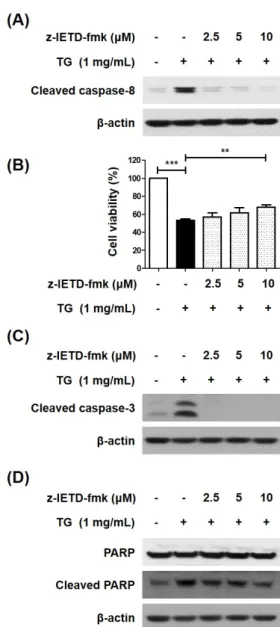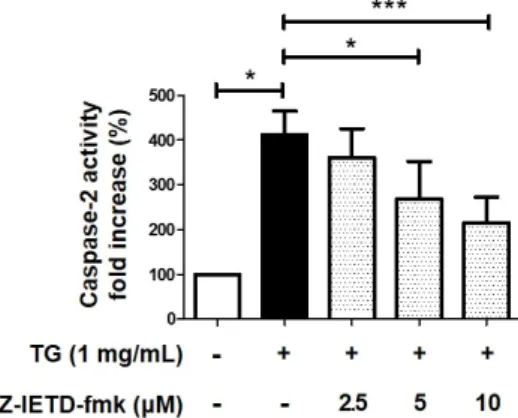Corresponding author: Yoon Suk Kim
Department of Biomedical Laboratory Science, College of Software and Digital Healthcare Convergence, Yonsei University, 1 Yeonsedae-gil, Heungeop-myeon, Wonju 26493, Korea
E-mail: yoonsukkim@yonsei.ac.kr
ORCID: https://orcid.org/0000-0002-1956-0126
†
These authors contributed equally to this work.
ORIGINAL ARTICLE
Caspase-8 Potentiates Triglyceride (TG)-Induced Cell Death of THP-1 Macrophages via a Positive Feedback Loop
Byung Chul Jung 1,2,† , Jaewon Lim 2,3,† , Sung Hoon Kim 2,4 , Yoon Suk Kim 2
1
Department of Nutritional Sciences and Toxicology, University of California, Berkeley, United States
2
Department of Biomedical Laboratory Science, College of Software and Digital Healthcare Convergence, Yonsei University, Wonju, Korea
3
Department of Biomedical Laboratory Science, College of Rehabilitation and Health, Daegu Haany University, Gyeongsan, Korea
4
Department of Biomedical Laboratory Science, Korea Nazarene University, Cheonan, Korea
Caspase-8의 양성 피드백 방식을 통한 중성지방-유도 THP-1 대식세포 사멸 증가
정병출 1,2,† , 임재원 2,3,† , 김성훈 2,4 , 김윤석 2
1
캘리포니아대학교 버클리캠퍼스 영양과학 및 독성학과,
2연세대학교 소프트웨어디지털헬스케어융합대학 임상병리학과,
3대구한의대학교 재활보건대학
임상병리학과,
4나사렛대학교 임상병리학과
ARTICLE INFO ABSTRACT
Received February 25, 2021 Revised April 5, 2021 Accepted April 13, 2021
Hypertriglyceridemia is the main risk factor for atherosclerosis. It is reported that triglyceride (TG) induces macrophage cell death, and is involved in the formation of plaques and development of atherosclerosis. We previously reported that TG-induced cell death of macrophages is mediated via pannexin-1 activation, which increases the extracellular ATP and subsequent increase in potassium efflux, thereby activating the caspase-2/caspase-1/apoptotic caspases, including the caspase-8 pathway. Contrarily, some studies have reported that caspase-8 is an upstream molecule of caspase-1 and caspase-2 in several cellular processes. Therefore, this study was undertaken to investigate whether caspase-8 influences its upstream molecules in TG-stimulated macrophage cell death. We first confirmed that caspase-8 induces caspase-3 activation and poly ADP-ribose polymerase (PARP) cleavage in TG-treated macrophages. Next, we determined that the inhibition of caspase-8 results in reduced caspase-1 and -2 activity, which are upstream molecules of caspase-8 in TG-induced cell death of macrophages. We also found that ATP treatment restores the caspase-8 inhibitor-induced caspase-2 activity, thereby implying that caspase-8 affects the upstream molecules responsible for increasing the extracellular ATP levels in TG-induced macrophage cell death. Taken together, these findings indicate that caspase-8 potentiates the TG-induced macrophage cell death by activating its upstream molecules.
Copyright Ⓒ 2021 The Korean Society for Clinical Laboratory Science. All rights reserved.
Key words Caspase-1 Caspase-2 Caspase-8 THP-1 macrophages Triglyceride
INTRODUCTION
Atherosclerosis is a chronic inflammatory disorder, which can be driven by the abnormal recruitment of circulating immune cells such as monocyte [1]. The recruited monocytes are infiltrated and thus differen-
Korean Society for Clinical Laboratory Science

